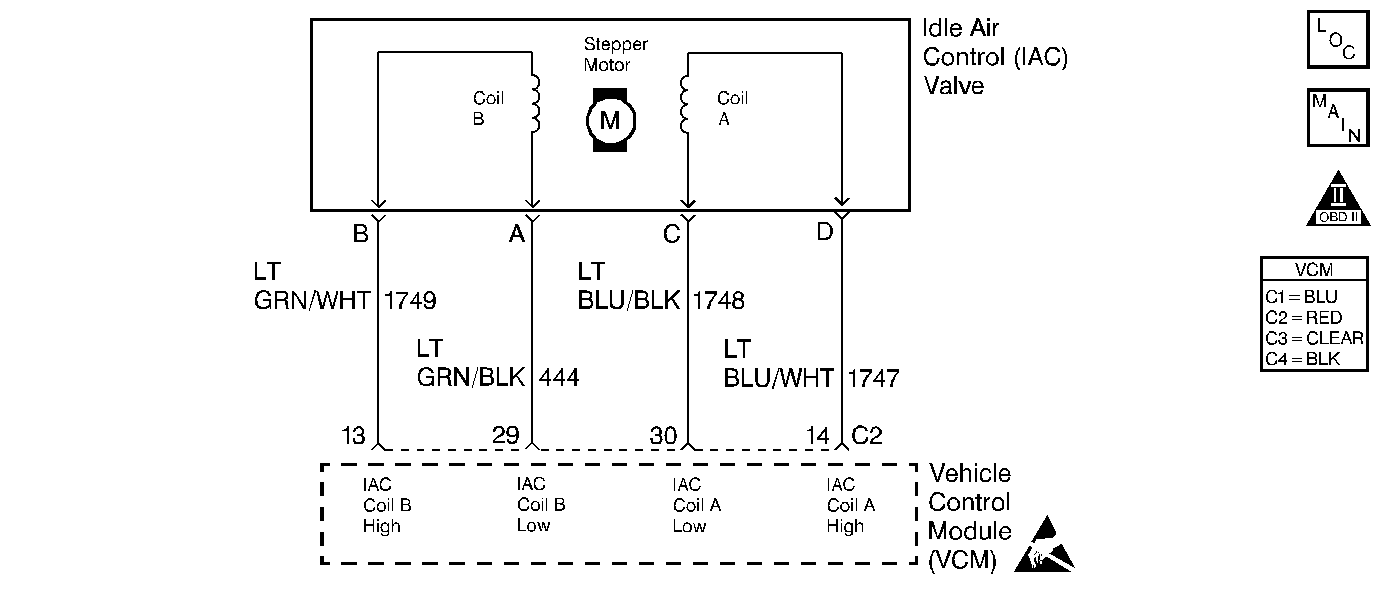
Circuit Description
The control module controls idle speed with an idle air control (IAC) valve. The desired RPM is based on sensor inputs and the actual engine RPM. Four circuits are used in order to control the IAC valve, allowing a precise amount of air into the intake manifold. In order to increase the idle RPM, the control module will command the valve pintle to move away from its seat, allowing more air to bypass the throttle plate. To decrease RPM, the control module commands the IAC pintle to move closer to its seat, causing a lower airflow to bypass the throttle plate. A scan tool will display the control module commands to the IAC valve in counts. The higher the counts, the more air is allowed to bypass the throttle plate. Lower counts indicate that less air is commanded by the control module.
Conditions for Running the DTC
| • | No active TP sensor DTCs |
| • | No active VS sensor DTCs |
| • | No active ECT sensor DTCs |
| • | No active MAP sensor DTCs |
| • | The ECT is greater than 50°C(122°F). |
| • | The system voltage is between 10-16 volts. |
| • | The IAT is greater than -25°C(-13°F). |
| • | The engine has been running for greater than 30 seconds. |
| • | The BARO is greater than 70 kPa. |
| • | The MAF is between 17.5-50 g/s. |
| • | The vehicle speed is between 25-85 mph. |
| • | Any change in throttle position is less than 1 percent. |
| • | Any change in engine speed is less than 50 RPM. |
| • | The IAC valve was commanded to move a specified number of counts. |
| • | The above conditions are present for more than 3 seconds. |
Conditions For Setting DTC
The change in MAF is less than 3 g/s.
Action Taken When the DTC Sets
The VCM will turn ON the MIL after 2 consecutive driving cycles with the fault active.
Conditions for Clearing the MIL or DTC
| • | The control module turns OFF the MIL after 3 consecutive drive trips when the test has run and passed. |
| • | A history DTC will clear if no fault conditions have been detected for 40 warm-up cycles. A warm-up cycle occurs when the coolant temperature has risen 22°C (40°F) from the startup coolant temperature and the engine coolant reaches a temperature that is more than 70°C (158°F) during the same ignition cycle. |
| • | Use a scan tool in order to clear the DTCs. |
Diagnostic Aids
The following items could cause this DTC:
| • | An IAC valve which is stopped and cannot respond to the VCM |
| • | A throttle stop screw which has been tampered with |
| • | A damaged throttle or linkage |
A slow, unstable, or fast idle may be caused by a non-IAC valve system problem that cannot be overcome by the IAC valve. Out of range control IAC scan tool counts will read above 60 if the idle is too low and zero if the idle is too high. Check for the following:
| • | Fuel system too lean or rich |
| • | Throttle body-- inspect the bore for foreign material |
| • | Refer to Rough, Unstable, or Incorrect Idle and Stalling . |
| • | IAC reset is done with the scan tool misc. functions mode. |
Step | Action | Value(s) | Yes | No |
|---|---|---|---|---|
1 |
Important: Before clearing the DTCs, use the scan tool in order to record the Freeze Frame and the Failure Records for reference. This information will be lost when the Clear DTC Information function is used. Was the Powertrain On-Board Diagnostic (OBD) System Check performed? | -- | ||
2 | Install the scan tool. Are any other DTCs set? | -- | Go to The Applicable DTC Table | |
3 | Is the DTC P0506 active this ignition cycle? | -- | ||
4 | This DTC is intermittent. Are there any additional DTCs stored? | -- | Go to The Applicable DTC Table | Refer to Diagnostic Aids |
5 | Problem is engine mechanical related. Refer to Engine Mechanical. Is the action complete? | -- | -- | |
6 |
Does the scan tool indicate that this diagnostic ran and passed? | -- | ||
7 | Use the scan tool in order to display the Capture Info and the Review Capture Info functions. Are there any DTCs displayed that have not been diagnosed? | -- | Go to The Applicable DTC Table | System OK |
